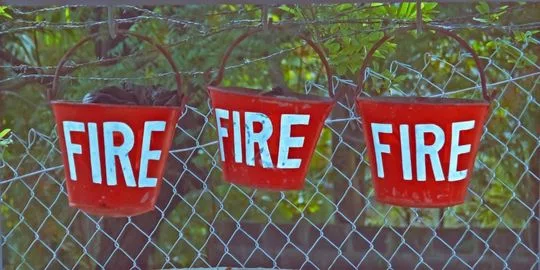The history of the fire bucket is connected with the history of general firefighting and the manufacture and production of metal and plastic products. In the 18th century, fire buckets were often made from leather, however, in modern times we typically use metal and plastic to carry sand or water contents. An estimated 358,000 fires occur every year with 50% of these originating in the kitchen of a domestic home. There are 22,000 workplace fires that occur every year and this works out at around 423 UK fires every week.
The main purpose of the fire bucket is to extinguish fires or contain them until specialist services arrive. Fire buckets are designed with a specific purpose in mind and depending on your requirements. You may need one that is specifically designed for certain types of fires. For example, if you work with flammable liquids then it is important that the bucket can contain the liquids in case of a spillage.
What Are Fire Buckets?
A fire bucket is generally filled with sand or water and used to extinguish fires. Sand is often used where there’s a risk of spilt flammable liquid igniting and spreading by flowing across the ground. The sand is used to create a barrier against the flowing liquid.
Fire buckets are often used in industrial settings and on construction sites. They’re also common in homes with wood stoves and fireplaces. Typically a fire bucket is painted bright red and will often have the word FIRE stencilled on the bucket. Additionally, the bottom of the bucket is convex and protrudes to result in easier handling and a stronger and more direct stream of sand or water. Fire buckets have many advantages, they are cheap, reliable, easy to use and can be quickly refilled.
Oil fires are resistant to water, but small fires can be effectively extinguished when the sand in the bucket is dumped on them. This method has generally been replaced by modern foaming agents.
Need A Fire Safety Risk Assessment?
What Do Fire Buckets Look Like?
Metal fire buckets are often bright red and have FIRE written in capital letters across the bucket in white. These buckets are strong and can be large enough to hold up to 10 litres of flame-smothering material. This makes them ideal for fighting Class A solid combustibles and Class B liquid combustible fires. If you wish to keep the contents covered, pair these metal buckets with a metal bucket lid.
Plastic fire buckets are also bright red with “FIRE” imprinted in white on the outside of the bucket. These buckets are slightly less robust than their metal counterparts.
Both buckets have a D-shaped base that allows them to be handled easier. In addition, thieves are put off from stealing these as they cannot be stood up on a flat surface and therefore have to be combined with wall hooks for storage.
Both metal and plastic buckets come with a handle for the convenience of pouring the contents over flames.

Where Are Fire Buckets Usually Used?
We offer a wide range of fire buckets made from both metal and plastic components. Fire buckets are handy tools that are ideal for use in garages, petrol stations, restaurants, campsites, barbeques, caravans, industrial environments and many other areas at risk of flammable liquid spillages.
Fire buckets are commonly used to prevent the risk of fires when handling flammable liquids. In addition, fire buckets are an essential item for use at campsites, BBQs and any outdoor event where there is a risk of flammable liquid being spilt onto hot surfaces.
How Does A Fire Bucket Work?
A fire bucket works like other fire extinguishers. Its purpose is to cut off the oxygen supply to the flame when filled with sand or water. Fire buckets are extremely effective and useful against Class A and Class B type fires. Fire buckets are relatively cheap, easy to use and very popular. They are considered the best option for camping use. They are also used in commercial settings, such as restaurants and buildings that have large amounts of flammable materials or those that store highly combustible liquids.
Conclusion
Fire buckets are a great and cost-effective way to keep you and your family safe from the dangers of fire. They are easy to use, inexpensive, portable and come in many different sizes and styles. Fire buckets have become popular among campers who want the added safety of having an extinguisher at hand when cooking over an open flame or other activities that can create sparks. Also, fire buckets are also used in commercial settings, such as restaurants and buildings that have large amounts of flammable materials or those that store highly combustible liquids. Fire buckets are a great way to keep you safe from the dangers of fire and should be included in any emergency kit.